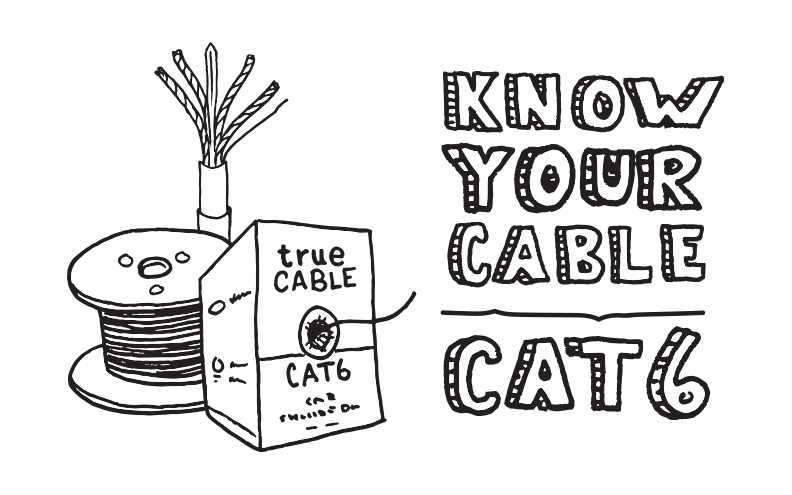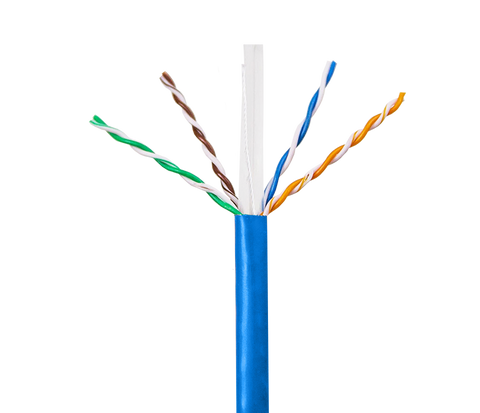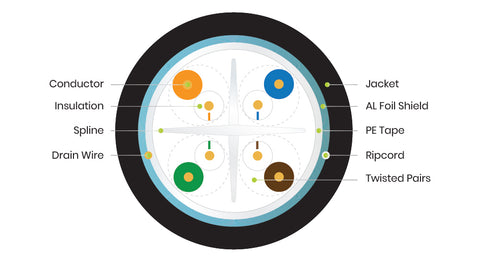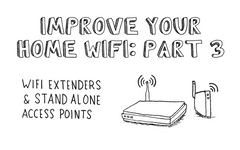Payment methods accepted

Cat6 Ethernet Cable: Which Ethernet Cables to Buy for Your Application
Written by Dave Harris, trueCABLE Technical Specialist, BICSI INST1 Certified and Don Schultz, trueCABLE Technical Manager, BICSI INSTC/INSTCF Certified and Fluke Networks Cable Test Technician
Continuing with our three-part series comparing the characteristics of Cat5e, Cat6 and Cat6A Ethernet cable, trueCABLE is exploring the benefits of Cat6. Knowing which cable to buy can save time and make your installation process simpler. We’re weighing performance versus cost to help you identify your best investment for the near future. Our experts at trueCABLE will explain how to choose an Ethernet cable and which one is best for your needs. Read on to learn more about the Cat6 Ethernet cable types.
What applications run on Cat6 Ethernet cables?
So, what is a Cat6 Ethernet Cable? Cat6 Ethernet cable is a cost-effective option for smart home installations, enterprise networks and electronic labs. It has more stringent performance specifications to enable higher speeds and more robust data transfer yet still keep an eye on a price point. With the potential for faster speeds, greater bandwidth, and less crosstalk, Cat6 cable has dominated enterprise and home networks as the cable of choice, but is being quickly supplanted by Cat6A for new installations.
Though slightly more costly than Cat5e, Cat6 cable can operate at higher network speeds and is a good fit for the wave of Power over Ethernet (PoE) technologies currently on the market, especially given that solid copper Cat6 structured cabling often uses 23 AWG copper conductors. Thicker copper equals higher current carrying capacity and better heat dissipation. Cat5e normally uses 24 AWG conductors (higher numbers are thinner gauges).
How is Cat6 different from Cat5e?
Cat6 Ethernet cable, which is a more conservatively priced option than Cat6A, supports speeds up to 10 gigabits per second (Gbps) at shorter distances of 165 feet or less. At the maximum channel length of 100 meters (328 feet) this is reduced to 5 gigabits per second (Gbp/s). Cat6 meets modern expectations for massive data transfer applications in deployments such as data centers, government websites, hospitals, and school systems.
Cat6 cable offers:
- More tightly wound wire pairs than Cat5e
- Typically a center spline
- Thicker copper conductors
- Thicker cable jacket compared to Cat5e
These features combine to provide higher performance and better resistance to interior cable noise, also known as crosstalk. Thicker cable jackets also help protect against cable-to-cable (alien) crosstalk (ANEXT), which starts becoming an issue at higher frequencies.
Interesting historical reference point: Cat5 (no “e”) Ethernet (long since deprecated) was the cabling widely used at the time 1000BASE-T was introduced and was designed to support 100 Mbp/s but had trouble reaching 1 Gbp/s. Cat5e was considered a “stop gap” measure to handle 1 Gbp/s networking until a better cable came along. The “better cable” that came along was Cat6. However, as manufacturing techniques improved over time Cat5e greatly improved while Cat6 was in development and Cat5e is still viable and in use today. Therefore, Cat6 never actually replaced Cat5e and now both are ANSI/TIA 568 recognized options. Cat6 has been called upon to do more over time as well.

Cat6 is still available at a budget friendly price point for larger installs and yet retains the possibility for future installation compatibility with switches that support IoT technology in-home or in the workplace.

Cross-section diagram of Category 6 unshielded Ethernet cable
How is Cat6 different from Cat6A?
Cat6A supports double the bandwidth frequency as Cat6 cable and can support 10 Gigabit Ethernet at 100 meters (328 feet). At these speeds Cat6 cabling can only transmit up to 55 meters (165 feet or less) under ideal conditions--but more often is limited to 120 feet in installations with significant ANEXT (large cable bundles) . Cat6A cables must be built to even higher performance specifications and often possess construction techniques that improve upon signal-to-noise ratio (SNR) of the original Cat6. Cat6, per the ANSI/TIA 568-2.D specification, supports 250 MHz bandwidth frequency and 5 Gbp/s transmission speed at 328 feet (100 meters). Cat6A cable must support bandwidth frequencies at 500 MHz and support 10 Gigabit speed to the maximum length that any Ethernet cable can be run (100 meters or 328 feet). The ANSI/TIA Cat5e bandwidth specification is only 100 MHz, and can support speeds of up to 2.5 Gbp/s transmission to the same distances.
Cost per foot
Now, you may be wondering, how much does Ethernet cable cost? The price you pay for Cat6 cable depends on several things. Shielding is more expensive but opens the possibilities for a broader range of deployments. Plenum cable is usually more expensive than riser cable. Bulk quantities are also budget friendly. Cat6 cable is more expensive than Cat5e, but less expensive than Cat6A.
Jacket ratings
Both shielded and unshielded Cat6 cable come in every type of jacket rating.
Outdoor rated (direct burial) Cat6 Ethernet cable has limited resistance to combustion but is designed for outdoor deployment. The linear low density polyethylene (LLDPE) jacket provides protection from the ultraviolet (UV) radiation in sunlight, and is much more resistant to water and severe weather than indoor cable.
Riser rated Cat6 Ethernet cable has some fire resistance and is designed to be used within the interiors of buildings, except for plenum spaces. A ”plenum space” is part of a building that is involved in air handling. Plenum spaces are often encountered above suspended ceilings or below raised floors.
Plenum rated Cat6 Ethernet cable is more fire resistant and designed to be used in the plenum spaces of buildings due to low toxicity smoke emitted if it actually burns.
For more information on cable jacket ratings, please read Facts About Ethernet Cable Jacket Ratings.
Maximum supported bandwidth at a given distance
Cat6 (802.3bz IEEE) can achieve 5 Gbp/s for up to 100 meters when deploying NBASE-T switching technologies such as 5GBASE-T. Cat6 and Cat5e both run at 1 Gbps at 328 feet without NBASE-T technology. As mentioned above, for shorter distance runs, Cat6 can support up to 10 Gbps speed to distances up to 165 feet. This is typically in environments where large data transfer is desirable, like hospitals, school districts and data centers, but where deployment of Cat6A (or replacement of current Cat6 cabling) would be cost prohibitive and 10 Gigabit speeds are not needed past that distance. It should be noted that 120 feet is the ANSI/TIA stated distance limit for 10 Gigabit transmission on Cat6 Ethernet cable under typical alien (cable to cable) crosstalk conditions but may be increased to 165 feet on a case by case basis depending on the installation environment. In any event, each installation is different and performance test results should be certified by qualified professionals to the ANSI/TIA 568-2.D specification with documented results.
Shielded Cable
Cat6 cable is available both with and without shielding. In certain installation environments, cable with one or more internal metallic shields is required. If the installation space presents electromagnetic interference such as that from AC power cables, motors, and transformers, shielded cable might be necessary. Also, if static charge can build up on the cable jacket, such as from air movement, then shielded cable will be needed. You can read more about shielded cable in our Cable Academy blog, “Shielded vs. Unshielded Cable.” Keep in mind that shielded Ethernet cable of any Category presents increased installation complexity and challenges due to weight, more restrictive bend radius limitations, and the requirement to bond the cable shield to ground.

Category 6 shielded Ethernet cable
Shielding terminology
The following acronyms are used to identify common types of Ethernet cable:
- U/UTP = Unshielded completely
- F/UTP = Overall foil shield, individual twisted pairs unshielded
- S/FTP = Overall screen braid shield, individual twisted pairs are foil shielded
- U/FTP = Unshielded overall, but individual twisted pairs are foil shielded
- SF/FTP = Overall screen braid AND foil shield, plus individual twisted pairs are foil shielded
There’s much more about shielding terminology in our blog, “Ethernet Cable Shielding Types.”

Cross-section diagram of Category 6 shielded Ethernet cable
Shielded termination hardware
To take full advantage of the benefits of shielded cable, be sure to use shielded termination hardware. The entire length of your cable installation is otherwise vulnerable to electromagnetic interference (EMI), including the ends. RJ45 plug termination on Cat6 cable may present a challenge as opposed to Cat5e due to the thickness of the cable, especially when the Cat6 cable is shielded. Conductor insulation diameter is an important metric for matching certain connectors to the correct cable. You can read more about hardware selection in our blog, “Choosing the Right Termination - Keystone Jack vs RJ45 Connector vs Field Termination Plug.”
Common bulk lengths sold (boxes versus reels)
Cat6 Ethernet cable may be purchased in lengths of 1,000 and 500 feet. Unshielded Cat6 Riser and Unshielded Cat6 Plenum are available in handy pull boxes.
Want to learn more about how to know which Ethernet cable to buy?
Read the other articles in this series:
Cat6A Ethernet Cable: Know Which Ethernet Cables to Buy for Your Application
Cat5e Ethernet Cable: Know Which Ethernet Cables to Buy for Your Application
So, why Cat6?
Quite frankly, Cat6 is extremely versatile. Often more than enough for home use, and typically “just enough” for business use, Cat6 cable is less expensive. Each installation is unique, and cable selection is more than “simply buy the faster cable”. Sometimes the fastest option is less desirable due to factors such as budget and ease of installation along with current and future needs. In installations that only require relatively short cable runs, Cat6 is often the most economical choice.
HAPPY NETWORKING!!
trueCABLE presents the information on our website, including the “Cable Academy” blog and live chat support, as a service to our customers and other visitors to our website subject to our website terms and conditions. While the information on this website is about data networking and electrical issues, it is not professional advice and any reliance on such material is at your own risk.

































